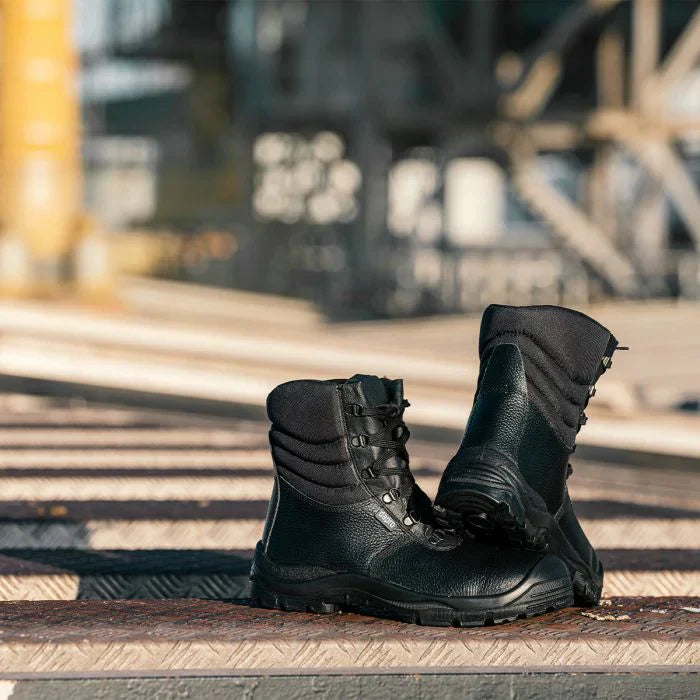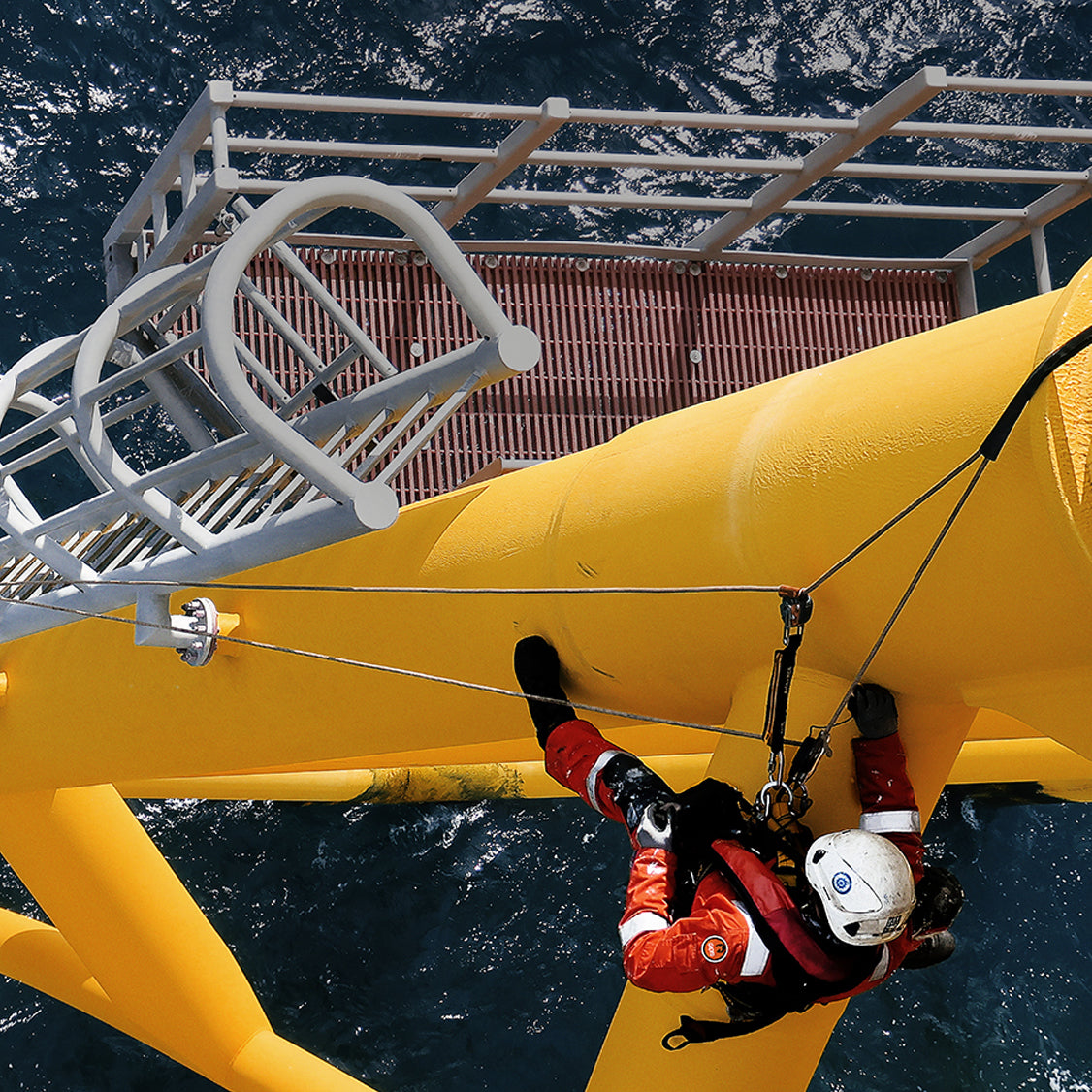Die neue Norm EN ISO 20345:2022 definiert die grundlegenden und zusätzlichen (optionalen) Anforderungen an Sicherheitsschuhe für allgemeine Zwecke. Sie umfasst unter anderem mechanische Gefahren, Rutschfestigkeit, thermische Gefahren und ergonomisches Verhalten.
Welche Auswirkungen haben die neuen Normen für Sicherheitsschuhe in der Praxis?
Im Jahr 2022 wurde die neue Norm für Sicherheitsschuhe mit dem Namen EN 20345:2022 veröffentlicht. Neben Anpassungen bestehender Anforderungen wurden mit dieser Norm auch neue Anforderungen gestellt.
Das Inkrafttreten der neuen Norm bedeutet allerdings nicht, dass Sicherheitsschuhe, die nach EN 20345:2011 zugelassen sind, nicht mehr verkauft werden dürfen. Sie dürfen weiterhin verkauft werden, bis das aktuelle Zertifikat für das Produkt ausläuft. Das bedeutet, dass Sicherheitsschuhe nach beiden Normen bis 2027 zulässig sind.
Was ist neu in der Norm EN ISO 20345:2022?
Die Norm definiert die grundlegenden und zusätzlichen (optionalen) Anforderungen an Sicherheitsschuhe für allgemeine Zwecke. Sie umfasst unter anderem mechanische Gefahren, Rutschfestigkeit, thermische Gefahren und ergonomisches Verhalten.
1. Anforderungen an die Rutschsicherheit
SRA, SRB und SRC entfallen. Rutschhemmende Prüfungen ähnlich SRA werden stattdessen in die Grundanforderung für die Zertifizierung aufgenommen und haben daher keine besondere Kennzeichnung.
Ergänzend zur Grundzertifizierung können Sie einen weiteren Rutschtest durchführen lassen, der dann die Kennzeichnung SR (Slip Resistance) trägt.
Bei Schuhen mit beispielsweise Stollen, deren normgerechte Prüfung in der Praxis schwierig oder gar nicht möglich ist, können Sie den Schuh mit folgendem Symbol kennzeichnen: .
Die Testmethoden werden leicht angepasst, um die Realität besser nachzubilden. Beispielsweise werden alle Rutschtests auf Fliesen durchgeführt.
2. Anforderungen an die Durchstoßfestigkeit
Ein mit einem Nageldurchtrittschutz ausgestatteter Schuh trug bisher die Kennzeichnung P.
Aus dieser Kennzeichnung ist jedoch nicht ersichtlich, aus welchem Material der Nagelschutz besteht. Die neue Norm stellt etwas klarer dar, aus welchem Material der Schutz besteht und welche Größe von Testnägeln bei den Tests verwendet wurde. Ein kleinerer Durchmesser führt zu einem höheren Druck und damit zu höheren Anforderungen an den Schutz.
P: Nagelschutz aus Stahl mit, Prüfnageldurchmesser 4,5 mm.
PL: Nagelschutz aus „Nichtmetall“ mit Prüfnageldurchmesser 4,5 mm.
PS: Nagelschutz aus "Nichtmetall" mit Prüfnageldurchmesser 3 mm.
3. Schutzniveau
Die Anzahl der Schutzstufen hat sich von SB - S5 auf SB - S7 mit den zugehörigen Unterstufen erhöht. Die bisherigen Schutzstufen waren wie folgt unterteilt: SB, S1, S2, S3, S4 und S5, wobei SB die einzige Schutzstufe ist, die eine offene Ferse erlaubt. S1 wurde manchmal mit einem zusätzlichen Nageldurchtrittschutz gesehen und hieß dann S1P. S4 und S5 sind sogenannte Produkte der Klasse II (Gummistiefel).
Die neue Hauptunterteilung lautet: SB, S1, S2, S3, S4, S5, S6 und S7. Die Schutzstufe S1 ist weiterhin mit dem Zusatz P gekennzeichnet, also S1P. Da die Prüfungen für den Nagelschutz jedoch auf P, PL und PS erweitert wurden, kann die Schutzstufe S1 daher mit diesen Zusätzen angegeben werden: S1P, S1PL und S1PS.
Andere Schutzstufen, die bereits Anforderungen an den Durchnagelschutz beinhalten, werden wie bisher nicht angegeben, da die Schutzstufe selbst bereits besagt, dass das Produkt diese Anforderungen erfüllt. Es ist jedoch interessant zu wissen, welche Art von Durchnagelschutz im Produkt enthalten ist. Beispielsweise wird die Schutzklasse S3 (Anforderung an den Durchnagelschutz ist in dieser Schutzklasse enthalten) daher in die folgenden drei Stufen unterteilt - S3, S3L und S3S. S3 wird mit einem Stahlnagel geprüft, S3L „nichtmetallischer“ Durchnagelschutz mit einem großen Nagel (L = Large) und S3S „nichtmetallischer“ Durchnagelschutz mit einem kleinen Nagel (S = Small). In gleicher Weise werden die Schutzstufen S5 und S7 unterteilt, da diese Schutzstufen auch Anforderungen an den Durchnagelschutz haben.

4. Besondere Anforderungen
Die Zahl der Zusatzanforderungen wurde von 12 auf 18 erhöht. Einige wurden entfernt und sind nun Teil der Basiszertifizierung, andere wurden hinzugefügt. Die neue Liste der 18 möglichen Zusatzanforderungen sieht folgendermaßen aus :
Codes und Anforderungen:
PL - Durchstoßfestigkeit (nicht metallischer Einsatz)
PS - Durchstoßfestigkeit (nicht metallischer Einsatz)
C - Teilweise leitfähiges Schuhwerk
A - Antistatisches Schuhwerk
HI - Wärmeisolierung des Außensohlenkomplexes
CI - Kälteisolierung des Außensohlenkomplexes
E - Energieabsorption im Sitzbereich
WR - Wasserbeständigkeit
M - Mittelfußschutz
AN - Knöchelschutz
CR - Schnittfestigkeit
SC - Überkappenabrieb
SR - Rutschhemmung (Keramikfliesenboden mit Glyzerin)
WPA - Wasserdurchdringung und -absorption
HRO - Widerstand gegen heißen Kontakt
FO - Beständigkeit gegen Heizöl
LG - Leitergriff

5. Leitergriff
Hierbei handelt es sich um eine Neuerung , die in früheren Versionen der Norm nicht berücksichtigt wurde. Es handelt sich dabei nicht um eine zwingende Grundvoraussetzung, sondern um eine optionale Prüfung.
Die Trittsicherheit eines Schuhs ( LG ) gibt Aufschluss über die Sicherheit beim Benutzen von Leitern. Die Ferse des Schuhs verhindert, dass der Fuß durch die Sprosse rutscht und beugt so Stürzen von der Leiter vor.
6. FO ist nicht mehr obligatorisch
Es gibt zwei Arten der Imprägnierung: WR und WPA. WPA ist die neue Bezeichnung von WRU. WRU wird nicht mehr verwendet. Die Wasserdichtigkeit des gesamten Schuhs wird weiterhin geprüft und hat die Kennzeichnung WR. Ein weiteres Merkmal, das geprüft werden kann, ist WPA. Dies gibt an, inwieweit das Obermaterial oder der Schaft des Schuhs wasserdicht sind. Diese Buchstaben gelten nur für Schuhe. Von Stiefeln wird erwartet, dass sie immer wasserdicht sind und der Dichtigkeitstest ist daher eine Grundanforderung (ohne Buchstaben).
7. Elastizität der Zehenkappe
Bisher wurde eine Zehenschutzkappe nicht geprüft. Künftig muss nachgewiesen werden, dass die Zehenschutzkappe wirksam dafür sorgt, dass die Schuhspitze weniger verschleißanfällig ist. Dies wird mit dem Code SC (Scuff Cap) gekennzeichnet.
8. Heizöl
Anders als in der neuesten Version der EN ISO 20345 ist Heizöl kein verpflichtender Test mehr für die S-Einstufung. Wer voraussichtlich regelmäßig mit Kraftstoff in Kontakt kommt, sollte die Version der Norm prüfen:
EN ISO 20345:2011 S1 wird an Kraftstoffen geprüft.
EN ISO 20345:2022 S1 wird nicht auf Kraftstoffe geprüft.
Bei Kontakt mit Kohlenwasserstoffen müssen Ihre Schuhe mit der Kennzeichnung FO versehen sein .



